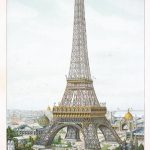A lithograph is a print which was originally created from a stone (lithographic limestone) or a metal plate with a smooth surface. It was invented in 1796 by German author and actor Alois Senefelder as a cheap method of publishing theatrical works. Lithography can be used to print text or artwork onto paper or other suitable material.
Lithography originally used an image drawn with oil, fat, or wax onto the surface of a smooth, level lithographic limestone plate. The stone was treated with a mixture of acid and gum arabic, etching the portions of the stone that were not protected by the grease-based image. When the stone was subsequently moistened, these etched areas retained water; an oil-based ink could then be applied and would be repelled by the water, sticking only to the original drawing. The ink would finally be transferred to a blank paper sheet, producing a printed page. This traditional technique is still used in some fine art printmaking applications. Reference: Wikipedia
This lithograph by Baron Gros is of an Arab chief waving a scarf to signal for help. It was made in 1817 and printed off the presses of Comte Charles-Philibert de Lasteyrie (1759–1849)
Reference:The Louvre
Lithographs were often used for labels on tins and bottles such as this label made by Troedel and Cooper Pty Ltd in Tasmania, Australia, 1920-1950.
Image from Museum of Applied Art and Sciences
This is a late 19th century color lithograph of the United States Fire Company of Philadelphia by G G Heiss.
It sold for 625 USD at Sotheby’s in 2019
A full length black and white lithograph showing Fanny Elssler dressed in a shin length, off the shoulder dress. Her right arm is upraised and she has a castanet in both hands. Her dress has a fitted bodice and an elaborate layered skirt and is trimmed with lace.
Circa 1838
Reference: © Victoria and Albert Museum
Alfred Jacob Miller executed this print as the cover for sheet music distributed by the Baltimore music publisher George Willig, Jr.
Reference: The Walters Art Museum
This is a Grand Prix de L’ace, 1935 advertising poster aftr Geo Ham. It is a colored lithograph on paper and was printed by Max Courteau of Paris, for the event at Autodrome de Linas-Montlhery, depicting cars from Italy, Germany and France, forming the colors of the French flag
It sold for € 18,825 (£ 16,854) inc. premium at Bonham’s in 2020








